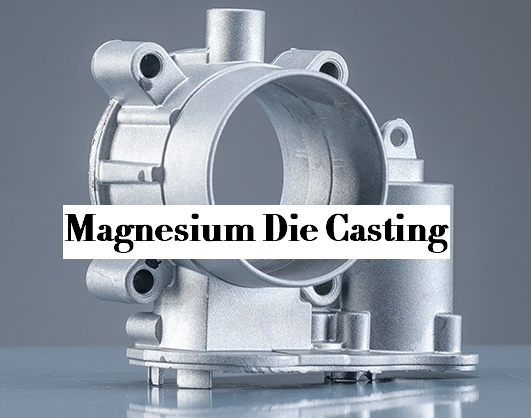One of the most common manufacturing methods of magnesium alloy is die casting, which includes two types of die casting processes: hot chamber die casting and cold chamber die casting. So what’s the difference between them?

Magnesium Hot Chamber Die Casting
Other than zinc and aluminum castings, another material used in die casting is magnesium. The basic difference between magnesium hot chamber die casting and cold chamber die casting is that in the hot chamber process, molten magnesium is stored in a closed steel crucible in a protected state. The valve allows a controlled volume of molten metal to enter the gooseneck, which is immersed in the molten metal. The plunger injects the metal into the cavity of the die through a nozzle. In order to prevent the metal from freezing, the nozzle can be heated by gas, electricity, or induction. In order to shorten the cycle time, the nozzle is often filled with molten magnesium between two injections.
Hot chamber die casting has obvious advantages in a magnesium die casting. First, it limits the contact between molten magnesium and air, thus avoiding or reducing the formation of oxides and flames. The sealing of molten metal in the crucible is protected by protective gas. Although Europe and China are now using less harmful alternatives to sulfur hexafluoride, the protective gas used in older facilities in North America is still sulfur hexafluoride (SF6). There are several alternative melt protection technologies on the market, and their performance is equivalent to that of SF6.
Some are based on patented AM covering fluorine-based mixed gas technology, which is similar to the technology used in the refrigeration industry, that is, the well-known HFC-134a. Others are specially tailored for the magnesium die casting industry, such as NOVEC 612 fluid, which is usually a liquid-gas conversion system using fluoroketone as the active ingredient and carrier gas (such as carbon dioxide or nitrogen and dry air). Some die casting companies are also using diluted sulfur dioxide. By using these SF6 substitutes, the global die casting industry can reduce greenhouse gas emissions and improve its environmental image. However, this change occurs too slowly, and even these newly prepared covering gases are harmful to the environment. So why not completely eliminate the demand for cover gas?
The new technology in die casting does not need to use any type of shielding gas, but uses the process of pretreatment and processing the cold magnesium chips with preferred metallurgical configuration in the die casting machine, so that the output is a solid part without shielding gas. Solid to solid (S2S) production mode is a safer, more environmentally friendly and cost-effective way. This will be an important direction for the future development of the magnesium die casting industry.
Magnesium Cold Chamber Die Casting
Cold chamber die casting is the most commonly used process in the mass production of magnesium castings. The molten metal is still contained in an open holding tank, which is put into the furnace and melted to the required temperature. However, the holding tank is kept separate from the die casting machine, and the molten metal is transferred from the tank during each casting, usually by pumping the molten metal from a large melting furnace into the peening chamber through the pouring hole.
The function of the injection system in the cold chamber machine is similar to that of the hot chamber machine; However, it is usually placed horizontally and does not include gooseneck channels. A hydraulically driven plunger forces molten metal through the injection chamber into the injection sleeve of the mold. The typical injection pressure range for cold chamber die casting machines is 2.500 (172 bar) to 25.000 PSI (1.724 bar). After the molten metal is injected into the mold cavity, the plunger remains forward and the pressure is maintained while the casting solidifies. After curing, the hydraulic system retracts the plunger and the clamping device ejects the parts.
Porosity of Magnesium Die Casting
Maintaining molten magnesium at a very high temperature (above 700 ° C, 1.292 ° F) is a very energy-consuming, unsafe, and environmentally friendly process. The change of temperature limits the strict quality control of castings. A large number of casting defects can be found by X-ray inspection. The biggest disadvantage of high-pressure cold chamber die-casting magnesium is the high porosity of the product, which is due to the gas entrainment caused by the injection of magnesium melt at a high speed during the injection process. Porosity is the killer of high integrity application of parts, but most automotive magnesium die castings are produced by cold chamber process because there is no better process to replace at present.
In applications requiring high integrity parts, other processes, such as vacuum die casting, can be selected. However, none of these processes can solve the safety and environmental problems of the die casting industry, because all these processes require a crucible filled with molten material, which must be kept at a very high temperature and prevent combustion.

